key MITSUBISHI ECLIPSE 1990 Service Manual
[x] Cancel search | Manufacturer: MITSUBISHI, Model Year: 1990, Model line: ECLIPSE, Model: MITSUBISHI ECLIPSE 1990Pages: 391, PDF Size: 15.27 MB
Page 4 of 391
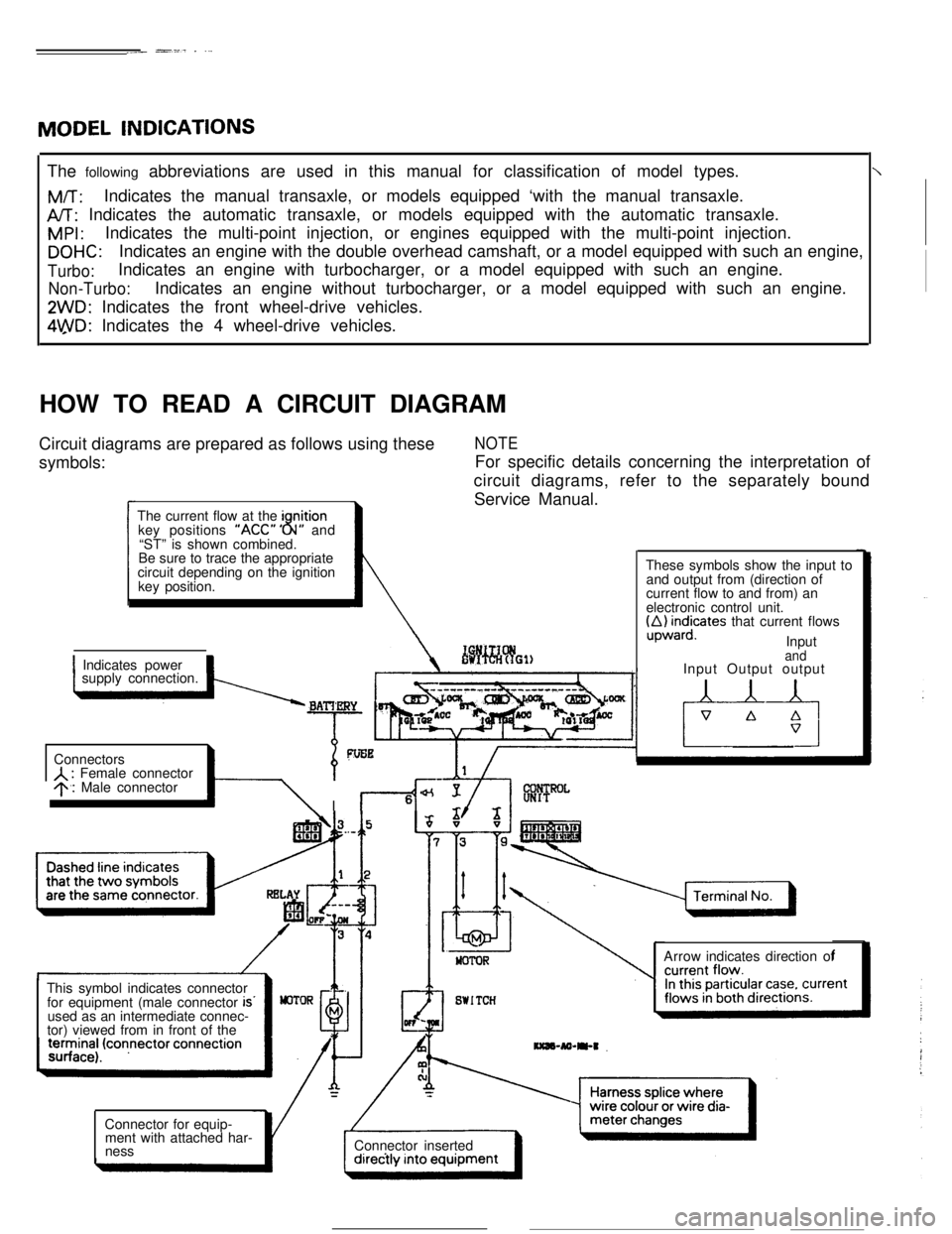
._._ -_- 1 -.
MODEL INDICATIONS
The following abbreviations are used in this manual for classification of model types.\
M/T: Indicates the manual transaxle, or models equipped ‘with the manual t\
ransaxle.
A/T: Indicates the automatic transaxle, or models equipped with the automatic\
transaxle.
MPI: Indicates the multi-point injection, or engines equipped with the multi-\
point injection.
DOHC: Indicates an engine with the double overhead camshaft, or a model equipp\
ed with such an engine,
Turbo: Indicates an engine with turbocharger, or a model equipped with such an \
engine.
2WD: Indicates the front wheel-drive vehicles.
4WD: Indicates the 4 wheel-drive vehicles.
HOW TO READ A CIRCUIT DIAGRAM
initionkey positions “ACC” ” N” and8“ST” is shown combined.
~
Service Manual.
o&ficates that current flows
Input
1 Indicates power1supply connection.
A : Female connector9.1 Male connector
\ Il-4’
Input Output output
is..used as an intermediate connec-
Page 11 of 391

GENERAL -Technical Featureso-74WD
(Four-wheel drive)The full time 4WD system adopts viscous coupling
unit (VCU) as the differential limiting device for thecenter differential of 4WD vehicle to achieve auto-
matic and ideal distribution of engine torque to the
front and rear wheels.
r_
Engine
00P0031Viscous coupling
Viscous coupling
(VCU) VP?limited slip differential (OptIOn)
A/TSAFETY-LOCK SYSTEMinterlock device) has been adopted to improve
JT safety-lock system (shift lock device and keysafety*FNKey interlock device
Ignition key cylinder
Shift lock device
Selector handle
AIT control cableShift lock cable
~ ^.._...
Page 12 of 391
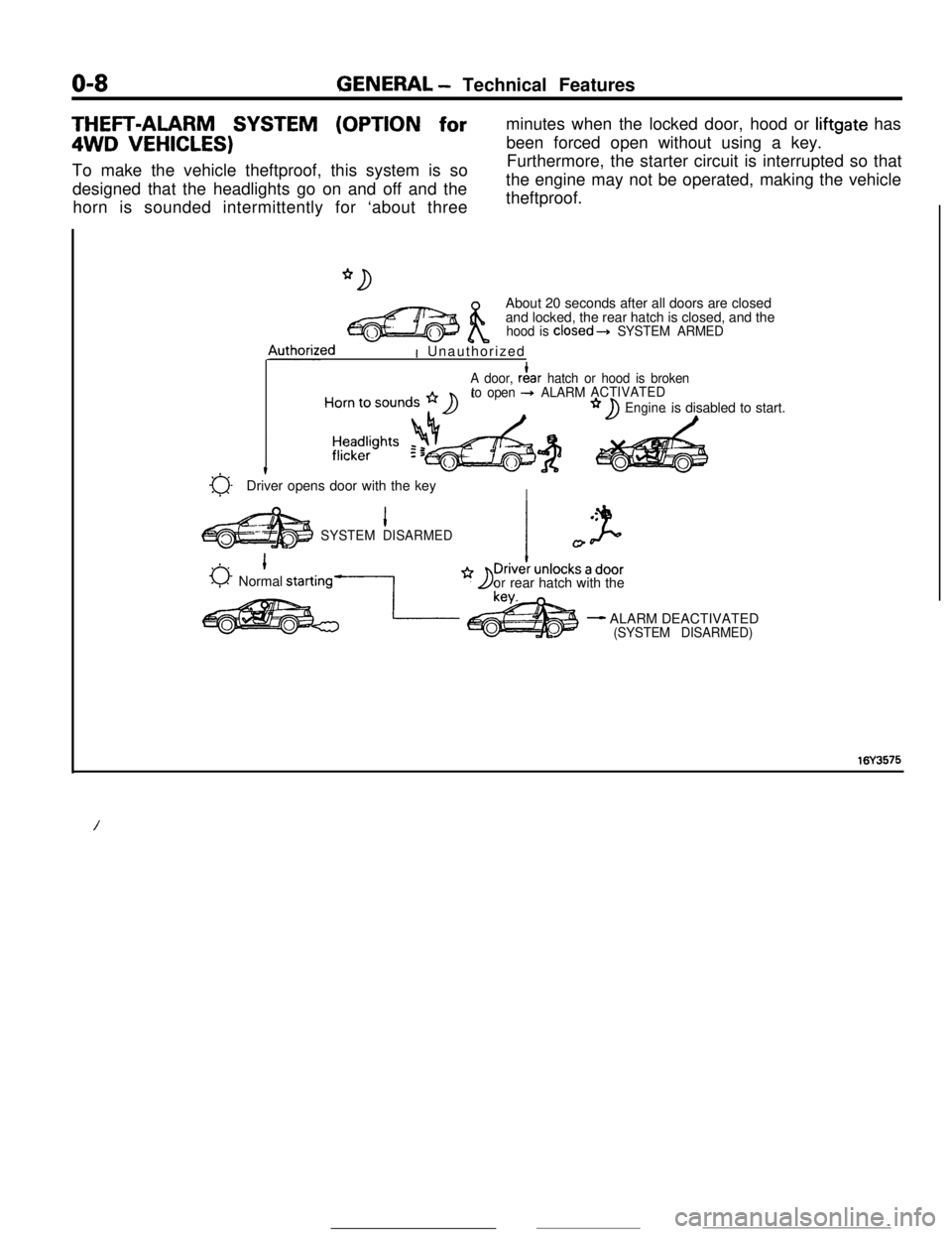
O-8GENERAL - Technical FeaturesTHEFT-ALARM SYSTEM (OPTION for4WD
VEHICLES)To make the vehicle theftproof, this system is so
designed that the headlights go on and off and the
horn is sounded intermittently for ‘about threeminutes when the locked door, hood or liftgate has
been forced open without using a key.
Furthermore, the starter circuit is interrupted so that
the engine may not be operated, making the vehicle
theftproof.
About 20 seconds after all doors are closed
and locked, the rear hatch is closed, and the
hood is closed---t SYSTEM ARMED4uthorized
I Unauthorized
A door, rf!ar hatch or hood is broken
to open + ALARMACTIVATED
Engineis disabled to start.
a-t
Driver opens door with the keyI
1SYSTEM DISARMED
0 1Normal starting-1
I
orrear hatch with the
- ALARM DEACTIVATED(SYSTEM DISARMED)
16Y3575
/
Page 55 of 391

ELECTRICAL - Fuses8-3q
rMULTI-PURPOSE FUSES
The multi-purpose fuses are located within the junction block at
the lower part of the instrument panel (at the driver’s seat side).
These fuses are all the blade type; 1 O-ampere, 15-ampere and
30-ampere fuses are used.
IPower supply circuitFuse No.
RatedLoad circuitapacity
(A)IBattery
t-lonition,itchBattery
IGz
ACC
IG,
10
10
10
15
15
10Automatic seatbelt control unit, buzzer, passing control relay,
key reminder switch, theft-alarm starter relay
Air conditioner control unit, air conditioner switch, heater relay,
power window relay, defogger timer, daytime running light relay
2
Door lock relay, door lock control unitAuto-cruise control unit
, AA control unit,
inhibitor switch, combination meter
ACC
IGI9
1011
12
1315
10
10
10Wiper motor, washer motor, intermittent wiper relay
Horn, headlight relay, theft-alarm control unit, daytime running
light relay
1
automatic seatbelt control unit, theft-alarm control unit,
combination meter, warning light, seatbelt timer
Turn-signal and hazard flasher u.nit
14
15
16
17
10Theft-alarm horn relay
30Blower motor
15Stop light
Back up light
CM/T>, dome light relay
!Dome light. luggage compartment
Irght, foot. Irght.door-ajar warntng light, radio, MPI control unrt.AK control unit, ignition key illumination light.security lightI
Page 74 of 391

8-22ELECTRICAL - Lighting--Ignition ON
switch OFF
prDoor ON
switch OFF
IDELAYED SWITCH-OFF DOME LIGHT
When the door is closed with the dome light switch in
thtDOOR position and ignition switch in the OFF position, the
dome light stays lit for a given period of time and then dims
before going out.
If the ignition switch’ is in the ON position, the dome light does
not dim but goes out as soon as the door is closed.
The foot light and ignition key illumination light operate in
exactly the same way.
16UOO94OPERATIONIgnition switch
(G)Fusible link a
Domelight
relay
9 Mutti-purpose
fuse
%69Ignition
key illu-
minatio
light
Domelight
Domelight
switch
Tr
;:16AO604
1.When a door is opened (the door switch placed
in the ON state) with the dome light switch in
the DOOR position, current flows from the
battery to the dome light to the dome light
switch (and the ‘foot light and ignition key
illumination light) to diode
DI to the door switch
to the ground, and the dome light lights.
2.When the ignition switch is in the OFF position,
L signal is input to the NOT circuit and inverted Hsignal input to the AND circuit. When the door is
-closed at this time (door switch OFF), the circuit
. .----es :- _.a -&Aso the AND circuit outputs
H signal to operate
the timer circuit.
The timer circuit outputs to the base of
Tr the
signal which gradually varies in about six
seconds. So the voltage applied to the light
-gradually reduced to cause the light to dim.
3.When the ignition switch is in the ON position,His input to the NOT circuit
ahd inverted L signal
input to the AND circuit. So when the door is
closed, the timer circuit does not operate, and
the light does not dim but goes out immediately.
_- .-._. ._-__._
Page 84 of 391

8-32ELECTRICAL - Theft-alarm System
THEFT-ALARM SYSTEM
NOOIAAAWhen the theft-alarm system has been armed by a
fixed sequence for locking the doors with the key or
without the key, if thereafter a door, the rear hatch
or the hood is opened in an unauthorized way. the
horn will sound intermittently for period of approx-
imately three minutes, and. at the same time, the
headlights will flash on and off, thus providing
audible and visual warning. signals.Furthermore, the starter circuit is interrupted in SIa way that the engine cannot be started, if
‘Lignition key is not used. Note that this system is
controlled by the electronic control unit (ECU).
This ECU includes an independent microcomputer
for the exclusive use of the theft-alarm system. This
microcomputer arms, disarms, activates and deacti-
vate the alarm system.
The system is composed of the components de-
scribed below.
Key-reminder
switchLiftgate unlock switch
!/Starter
Door key cylinder
”daytime running light relay Security
lig
ECU
I
HornOPERATION
iAbout
20 seconds after all doors are closed
and locked. the rear hatch is closed. and the
hood is closed + SYSTEM ARMED
. .‘11A door rear hatch or hood is brokenALARM ACT,“ATED
* n Engine is disabled to start.
Headlights
Iflicker
*.
.u Driver opens door with the key
I.l .
SYSTEM DISARMEDI J-0
-IDriver unlocks a door
0 Normal starting -1or rear hatch with the*D key.
- ALARM DEACTIVATED(SYSTEM DISARMED)
Page 85 of 391
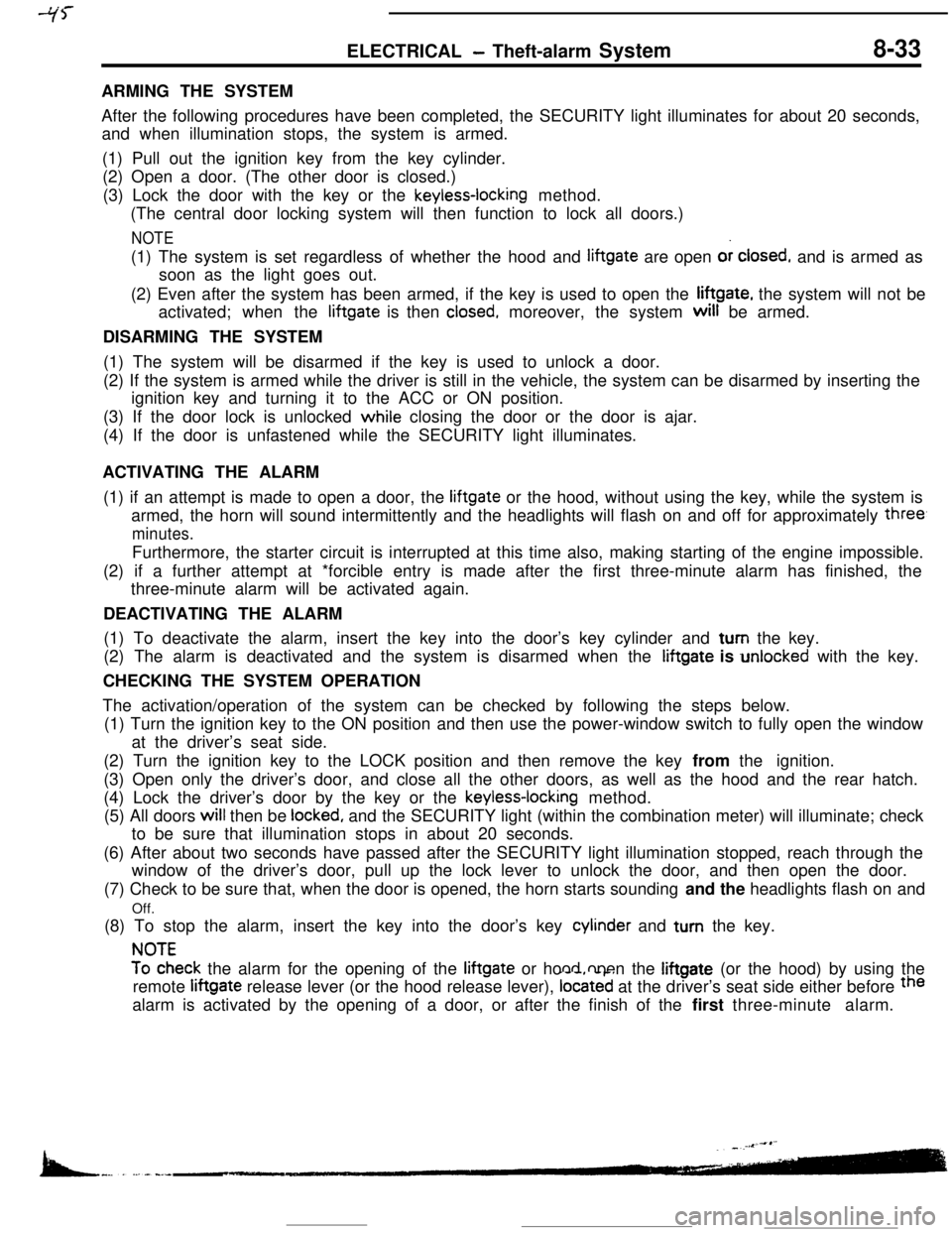
ELECTRICAL - Theft-alarm System8-33ARMING THE SYSTEM
After the following procedures have been completed, the SECURITY light illuminates for about 20 seconds,
and when illumination stops, the system is armed.
(1) Pull out the ignition key from the key cylinder.
(2) Open a door. (The other door is closed.)
(3) Lock the door with the key or the
keyless-locking method.
(The central door locking system will then function to lock all doors.)
NOTE(1) The system is set regardless of whether the hood and liftgate are open or
closed, and is armed as
soon as the light goes out.
(2) Even after the system has been armed, if the key is used to open the liftgate, the system will not be
activated; when the liftgate is then
closed, moreover, the system will be armed.
DISARMING THE SYSTEM
(1) The system will be disarmed if the key is used to unlock a door.
(2) If the system is armed while the driver is still in the vehicle, the system can be disarmed by inserting the
ignition key and turning it to the ACC or ON position.
(3) If the door lock is unlocked while closing the door or the door is ajar.
(4) If the door is unfastened while the SECURITY light illuminates.
ACTIVATING THE ALARM
(1) if an attempt is made to open a door, the liftgate or the hood, without using the key, while the system is
armed, the horn will sound intermittently and the headlights will flash on and off for approximately
three,
minutes.Furthermore, the starter circuit is interrupted at this time also, making starting of the engine impossible.
(2) if a further attempt at *forcible entry is made after the first three-minute alarm has finished, the
three-minute alarm will be activated again.
DEACTIVATING THE ALARM
(1) To deactivate the alarm, insert the key into the door’s key cylinder and turn the key.
(2) The alarm is deactivated and the system is disarmed when the iiftgate is unlocked with the key.
CHECKING THE SYSTEM OPERATION
The activation/operation of the system can be checked by following the steps below.
(1) Turn the ignition key to the ON position and then use the power-window switch to fully open the window
at the driver’s seat side.
(2) Turn the ignition key to the LOCK position and then remove the key from the ignition.
(3) Open only the driver’s door, and close all the other doors, as well as the hood and the rear hatch.
(4) Lock the driver’s door by the key or the
keyless-locking method.
(5) All doors will then be
locked, and the SECURITY light (within the combination meter) will illuminate; check
to be sure that illumination stops in about 20 seconds.
(6) After about two seconds have passed after the SECURITY light illumination stopped, reach through the
window of the driver’s door, pull up the lock lever to unlock the door, and then open the door.
(7) Check to be sure that, when the door is opened, the horn starts sounding and the headlights flash on and
Off.
(8) To stop the alarm, insert the key into the door’s key cylinder and turn the key.
!?iEeck the alarm for the opening of the liftgate or hood open the liftgate (or the hood) by using the
remote liftgate release lever (or the hood release lever),
located at the driver’s seat side either before the
alarm is activated by the opening of a door, or after the finish of the first three-minute alarm.
Page 243 of 391
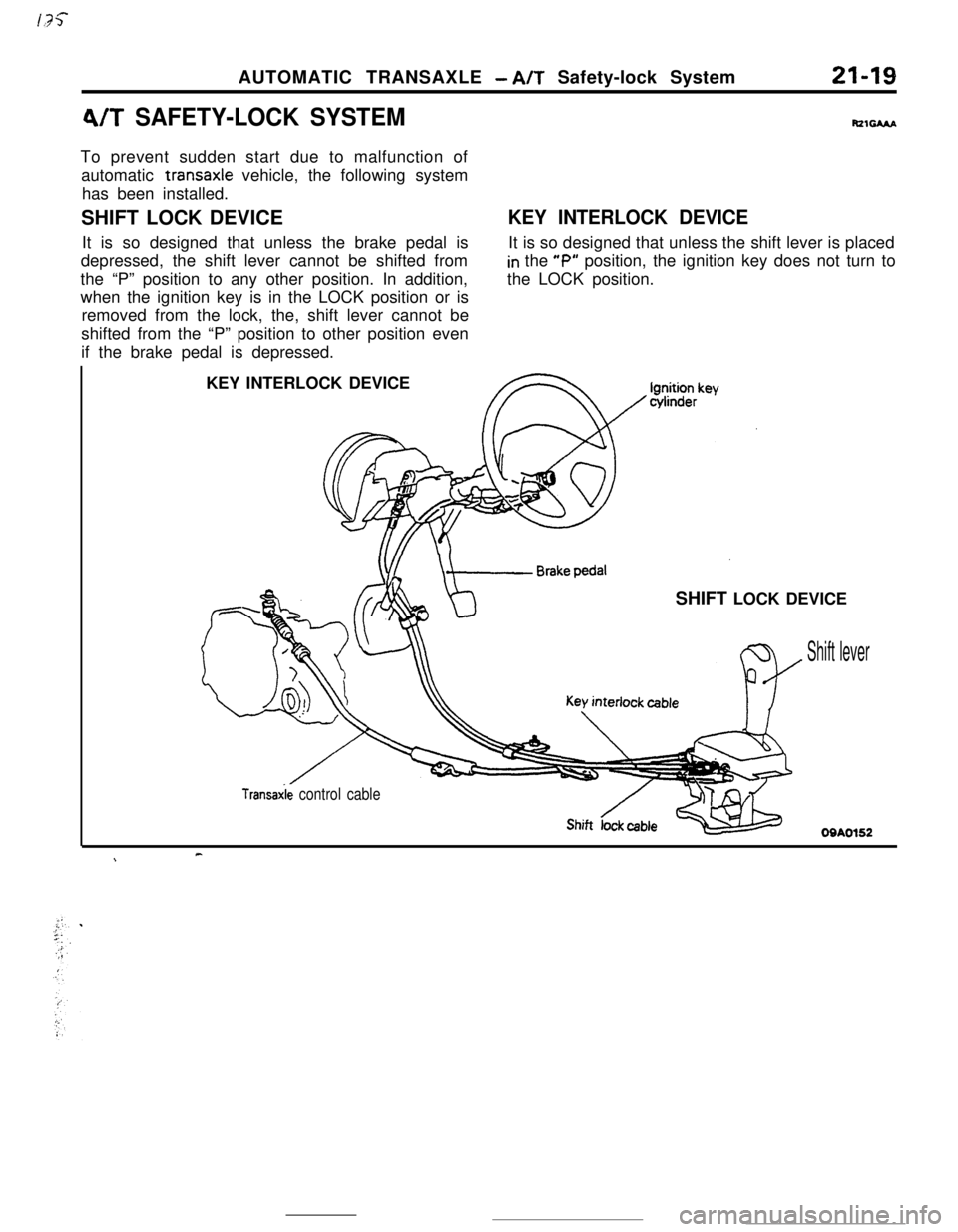
AUTOMATIC TRANSAXLE - A/T Safety-lock System21-19
4/T SAFETY-LOCK SYSTEMRzsAAaTo prevent sudden start due to malfunction of
automatic transaxle vehicle, the following system
has been installed.
SHIFT LOCK DEVICE
It is so designed that unless the brake pedal is
depressed, the shift lever cannot be shifted from
the “P” position to any other position. In addition,
when the ignition key is in the LOCK position or is
removed from the lock, the, shift lever cannot be
shifted from the “P” position to other position even
if the brake pedal is depressed.
KEY INTERLOCK DEVICEIt is so designed that unless the shift lever is placed
in the “P” position, the ignition key does not turn to
the LOCK position.
KEY INTERLOCK DEVICE
SHIFT LOCK DEVICE
Shift lever
Transaxie control cable
Shift dieOQA0152
c\
Page 244 of 391
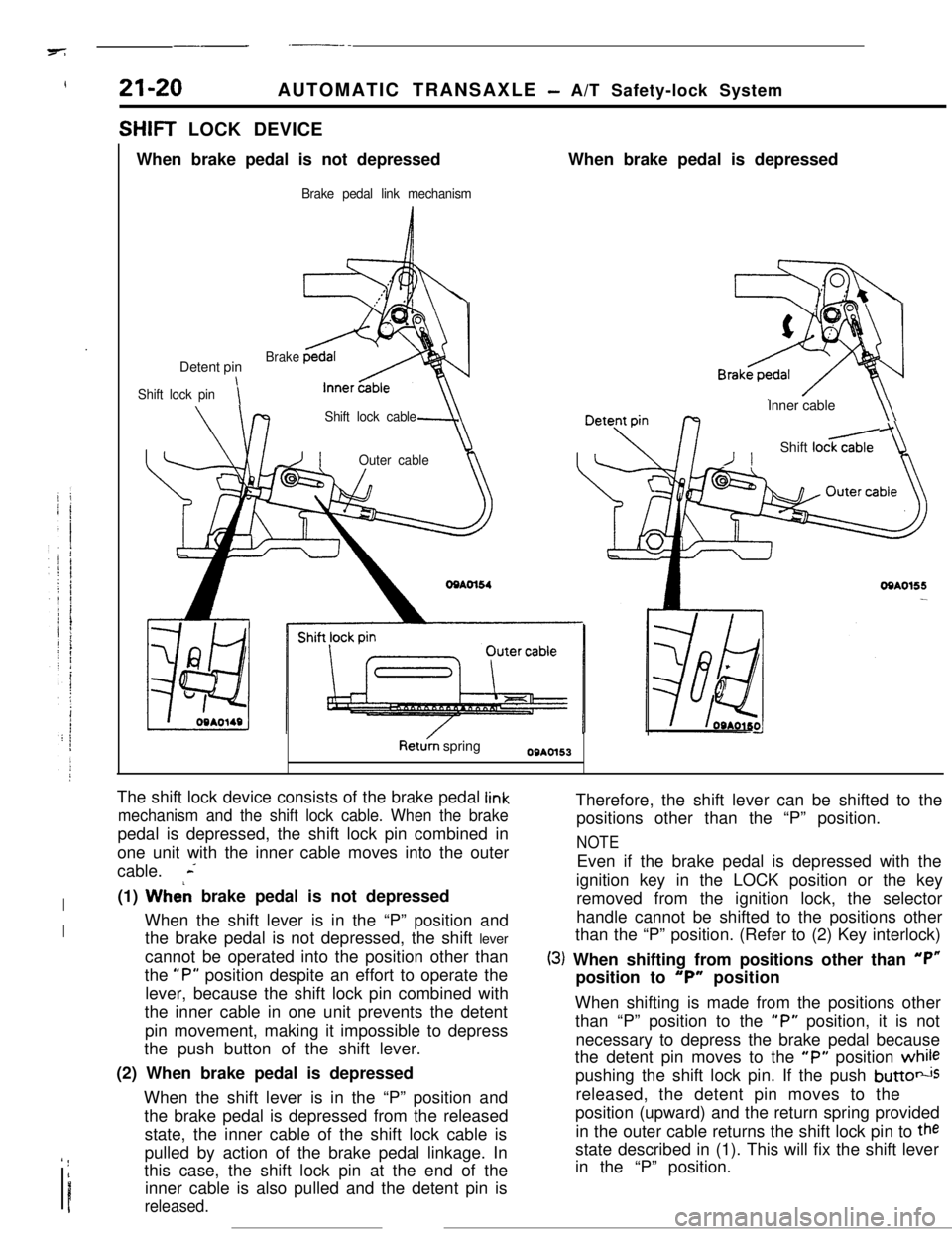
-_ - .--.7
!21-20AUTOMATIC TRANSAXLE - A/T Safety-lock System
SHIFT LOCK DEVICE
When brake pedal is not depressed
Brake pedal link mechanismWhen brake pedal is depressed
Detent pin
Shift lock pini
Brake
Shift lock cable
-JIOuter cableInner cable
\\
/IShift loc&
OQAO155-
Ret& springOBAOl53
The shift lock device consists of the brake pedal
link
mechanism and the shift lock cable. When the brakepedal is depressed, the shift lock pin combined in
one unit with the inner cable moves into the outer
cable.
L
I(1) Wheh brake pedal is not depressed
IWhen the shift lever is in the “P” position and
the brake pedal is not depressed, the shift lever
cannot be operated into the position other than
the
“P” position despite an effort to operate the
lever, because the shift lock pin combined with
the inner cable in one unit prevents the detent
pin movement, making it impossible to depress
the push button of the shift lever.
(2) When brake pedal is depressed
When the shift lever is in the “P” position and
the brake pedal is depressed from the released
state, the inner cable of the shift lock cable is
’ !I
Ipulled by action of the brake pedal linkage. In
this case, the shift lock pin at the end of the
inner cable is also pulled and the detent pin isreleased.Therefore, the shift lever can be shifted to the
positions other than the “P” position.
NOTEEven if the brake pedal is depressed with the
ignition key in the LOCK position or the key
removed from the ignition lock, the selector
handle cannot be shifted to the positions other
than the “P” position. (Refer to (2) Key interlock)
(3) When shifting from positions other than “P”position to
“P” position
When shifting is made from the positions other
than “P” position to the
“P” position, it is not
necessary to depress the brake pedal because
the detent pin moves to the
“P” position whilepushing the shift lock pin. If the push
buttotisreleased, the detent pin moves to the
position (upward) and the return spring provided
in the outer cable returns the shift lock pin to
thestate described in (1). This will fix the shift lever
in the “P” position.
Page 245 of 391
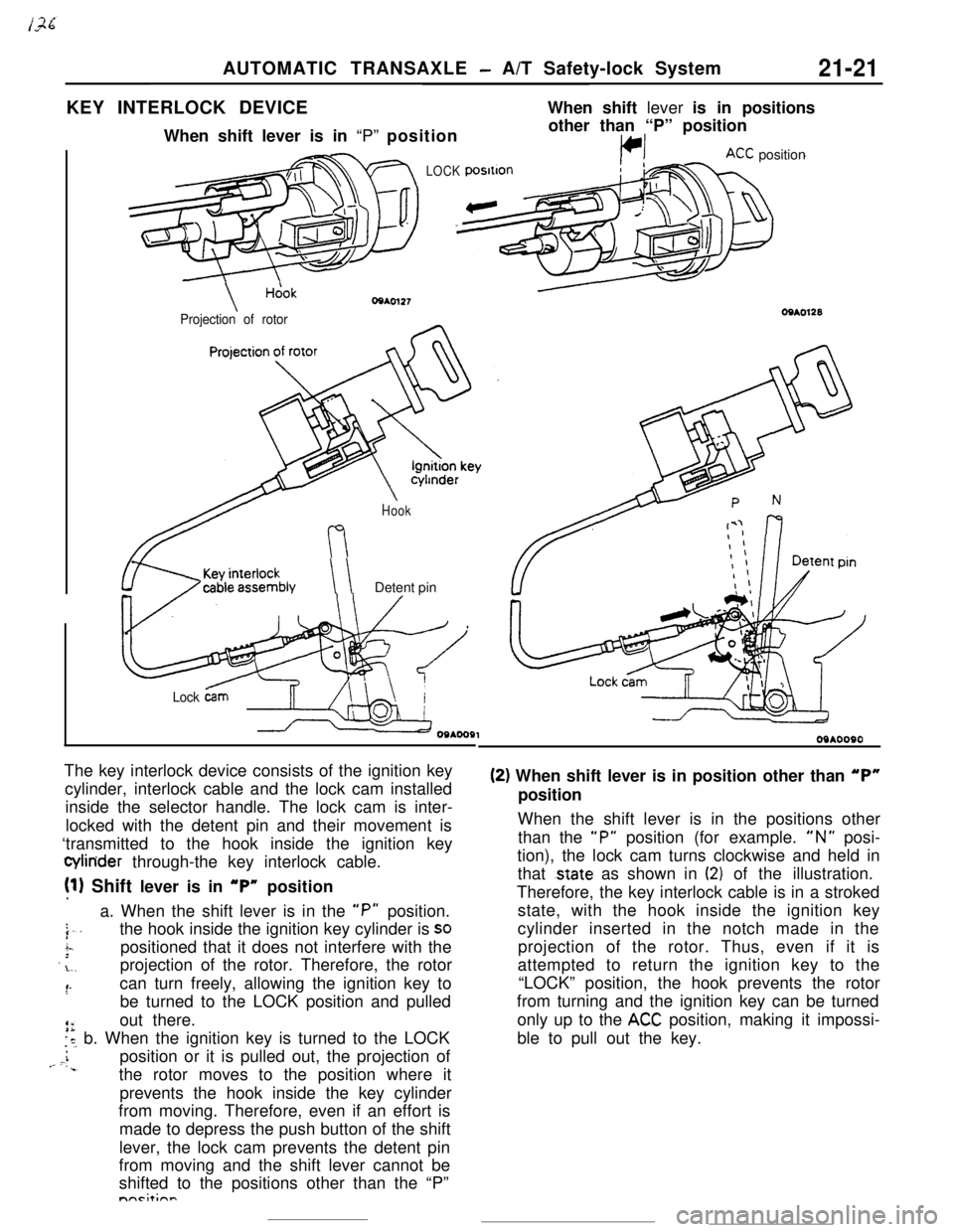
AUTOMATIC TRANSAXLE - A/T Safety-lock System21-21KEY INTERLOCK DEVICEWhen shift lever is in positions
When shift lever is in “P” position
LOCK
\Hcjok
Projection of rotorother than “P” position
KC position
Hook
\ \Detent pin
Lock &mThe key interlock device consists of the ignition key
cylinder, interlock cable and the lock cam installed
inside the selector handle. The lock cam is inter-
locked with the detent pin and their movement is
‘transmitted to the hook inside the ignition key
Q4inder through-the key interlock cable.
!l) Shift lever is in “P” position
a. When the shift lever is in the
“P” position.
j..the hook inside the ignition key cylinder is SO
i-.3positioned that it does not interfere with the’ .L.,projection of the rotor. Therefore, the rotor
:‘-can turn freely, allowing the ignition key to
be turned to the LOCK position and pulled
out there.
is, b. When the ignition key is turned to the LOCK
i,- c.position or it is pulled out, the projection of‘..the rotor moves to the position where it
prevents the hook inside the key cylinder
from moving. Therefore, even if an effort is
made to depress the push button of the shift
lever, the lock cam prevents the detent pin
from moving and the shift lever cannot be
shifted to the positions other than the “P”nnrit;nn
09*0090
(2) When shift lever is in position other than “P”position
When the shift lever is in the positions other
than the
“P” position (for example. “N” posi-
tion), the lock cam turns clockwise and held in
that
.state as shown in (2) of the illustration.
Therefore, the key interlock cable is in a stroked
state, with the hook inside the ignition key
cylinder inserted in the notch made in the
projection of the rotor. Thus, even if it is
attempted to return the ignition key to the
“LOCK” position, the hook prevents the rotor
from turning and the ignition key can be turned
only up to the
ACC position, making it impossi-
ble to pull out the key.